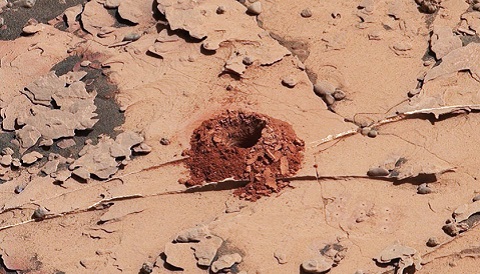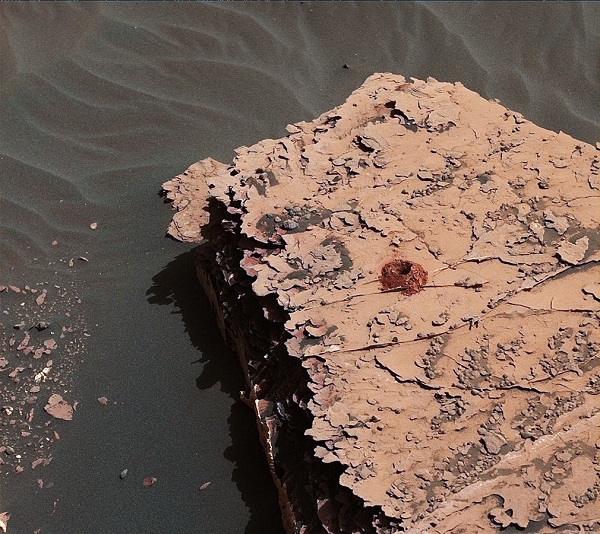An innovative technique has allowed NASA's Curiosity Rover to resume drilling Martian rocks. But more work remains to be done.
| Update (June 4, 2018): A second drill test occurred on May 22nd, where the team was able to improve the delivery method. While the first test on May 20th delivered too little material for the onboard laboratories to analyze, the second test was successful in delivering the right amount of material to the mineralogy lab. Delivery to the chemistry lab will occur in the coming week. Read more from NASA JPL's press release. |

NASA / JPL-Caltech / MSSS
It's game on once again for Curiosity.
After a 19-month hiatus, the Mars Curiosity rover resumed drilling and rock sampling on May 20th using a new technique known as percussive drilling. Curiosity successfully drilled a hole 2 inches (50 millimeters) deep into a rock named Duluth, which is located along Vera Rubin ridge in Gale Crater.
“The team used tremendous ingenuity to devise a new drilling technique and implement it on another planet,” says Steve Lee (NASA-JPL) in a recent press release. “ We're thrilled that the result was so successful.”
Engineers worked on the solution for more than a year. They conducted a brief test using the new method earlier this year on a target dubbed Lake Orcadie. Curiosity had drilled 15 samples on Mars before issues began cropping up in October 2016.

NASA / JPL-Caltech / MSSS
Problems first arose in late 2016, when the retraction mechanism on Curiosity's drill became unreliable, maybe because internal debris caused the drill feed brake to jam.The standard drilling procedure for Curiosity was to place two stabilizer posts, which are mounted on the front of the drill, onto the target rock, then extend the drill into the rock. The drill was then retracted along with the sample, which is processed and delivered to the onboard laboratories for analysis. Unreliable retraction meant NASA had to halt all drilling.
Dealing With a Stubborn Drill
It's easy to see where NASA's concern lies: if, for example, the drill bit were retracted and could not extend again, Curiosity's drilling days would be over. The rover would also be unable to eject and swap out a broken bit for one of the two onboard spares it carries on the main deck.
Saddled with a balky drill retraction mechanism, engineers came up with a method known as percussive or feed extended drilling, where Curiosity keeps its drill permanently extended and uses the robotic arm, on which the drill is mounted, to push the drill into the rock. Engineers have a copy of Curiosity, informally called Maggie, in the lab at JPL where they tested this method before putting it into use on Mars.
Implementing this technique offered NASA a quick sample of the Vera Rubin Ridge before the rover moves onward.
Feed extended drilling must also account for the robotic arm's five degrees of freedom — the extractor mechanism only had one degree of freedom. The new process is similar to drilling holes in a wall free-handed, holding a cordless drill with only your arm.
But resuming drilling only solves half of the problem. Engineers must also instruct the arm to deliver the resulting sample to the laboratories within the rover while keeping the drill extended. Cameras aboard Curiosity watched to see how much of the sample was lost when the drill ran backward out of the rock and during transport to the lab. The team then used the drill's built-in percussion mechanism to tap out the powder into the sample inlet chamber for analysis.
The new transfer method is akin to drilling into plaster or sheet rock, then attempting to carry bits of plaster still clinging to the knurled drill bit to a container across the room. Previous drill samples were strained and then processed in the Collection for Handling In-Situ Martian Rock Analysis chamber (CHIMRA), one of five devices located on the rotating turret at the end of the robotic arm. That method is no longer an option now that the drill bit can't retract and extend reliably.
Unfortunately, there were problems over the weekend as the team used the new sample drop-off technique for the first time. Kenneth Herkenhoff (USGS-Astrogeology Science Center) stated on his Mars Rover Curiosity: Mission Update blog that: “Some of the Duluth drill sample was dropped into CheMin (the Chemistry and Mineralogy spectrometer) on Sol 2061, but not enough for a proper mineralogical analysis.”
NASA engineers plan to give the new drill-and-transfer method another go this week.

NASA / JPL-Caltech / MSSS
Though drill issues and chewed up tires have plagued Curiosity, it's nevertheless been a hugely successful mission overall. The nuclear-powered SUV-sized rover has already lasted long past its 687-day warranty, which started on its August 6, 2012, landing on the flanks of Mount Sharp (Aeolis Mons). As with Spirit and Opportunity (the latter of which is still exploring Meridiani Planum), NASA will look at ways to obtain the most it can out of Curiosity. Lessons learned now will be applied to the Mars 2020 Rover, set to head to the Red Planet in July 2020.
 0
0








